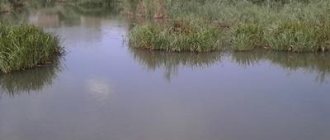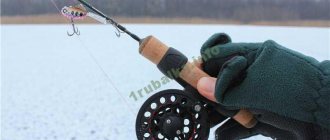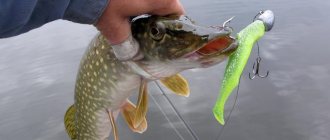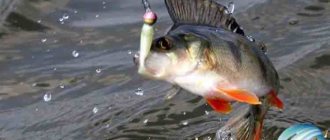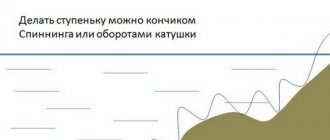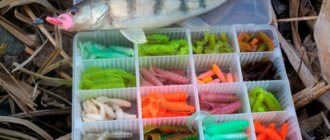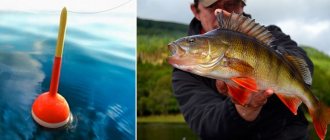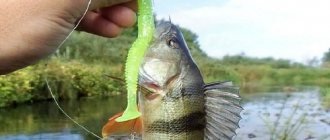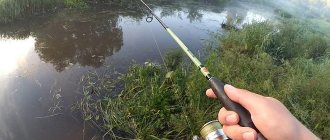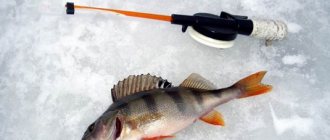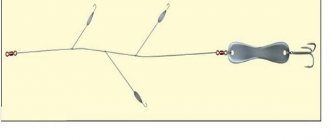Catching perch with a jig can be especially effective in the second half of summer and during the fall, when the striped predator gathers in schools and begins to chase the fry along the surface. That is why many spinning anglers use jig baits during this period.
Observations have shown that it has a simply magical effect. This can be explained by the fact that when reeling this bait looks very natural, its movements resemble small fish - the main food of perch. In this article we will understand in detail how to catch perch with a jig, we will talk in detail about all aspects of such fishing and all its subtleties.
The classic jig can be used almost anywhere, be it fast-flowing rivers or ponds with standing water. Intense currents, deep holes, snags, and areas overgrown with grass will not become an obstacle to jig fishing.
Here it’s just the opposite - the peculiarity of the gear will allow you to more effectively explore such places. But in shallow water, using a jig is ineffective.
Tackle and equipment
When choosing gear for catching perch with jigs, you need to carefully approach each of its components. And although the most important element is the rod, the reel and line also play an important role.
Spinning
For fishing, a spinning rod with a medium or medium-fast action, preferably a plug type, is suitable. Its length is around 2.2-2.5 meters - for fishing at a considerable distance and 1.8-2.1 meters at close range. A big plus will be the movable top. It will allow you to provide the necessary control over the bait, as well as feel the slightest bite of the perch.
Its grip is not as powerful as that of other predators, so the rod must respond promptly to any contact of the fish with the bait. In addition, good shock absorption at the time of fishing is important, which will completely dampen the jerks of the fish, preventing it from falling off the hook. The spinning rod should be light, since jig fishing for perch at times involves numerous jerking retrieves.
Spinning test about 10-25 grams. This is quite enough to fish with equal success both shallow depths with slow currents with light baits, and areas with sharp changes in bottom relief and significant flow, using weighted sinkers.
Coil
The reel is only inertialess, size 2000-2500. Considering the use of jerk wiring, a mandatory requirement for it is the ability to lay the line evenly and a sensitive drag.
It is this that contributes to proper balancing of the tackle, and will also allow you to save bait when hooked and actively resisted by large fish. A power or high-speed reel is not needed here; rather, a universal option would be better suited. The coil reduction is usually 1:5.
In some cases, multiplier reels can be used to catch large perch at significant depths using heavy weights.
fishing line
As for the fishing line, it is best to use braid with a diameter of 0.1-0.12 mm, especially if you are fishing long-distance - from 25 meters or more. The use of mono fishing line, usually with a diameter of 0.18-0.2 mm, is justified in cases where you are fishing in difficult areas where the braid will quickly wear out. Or - when fishing at short distances up to 20 meters. Therefore, some anglers always try to have a spool with each type of fishing line.
A metal leash is not used for perch fishing; instead, a leash made of fluorocarbon fishing line will suffice.
Jig lures
Perch on jigs can be caught with equal success using almost all types of baits, but silicone ones remain in first place. In most cases, standard twisters and vibrating tails are used.
- Twister is a typical jig bait that is in great demand among perch anglers.
- The vibrotail is shaped exactly like a small fish. Vibrating tails with side notches are especially distinguished by their realistic behavior.
A large bait is not needed, generally it is up to 2-2.5 inches in length. If there is a targeted hunt for trophy perch, then the size of the bait increases to 3-3.5 inches.
Good results when catching perch are shown by “edible rubber”, which, due to its aromatization, looks more attractive to the striped predator, and often helps out when the perch is inactive.
Among all the listed types of baits, the following models are the most catchy, according to most anglers:
- Reins Rockvibe Shad
- Lucky John Tioga
- Gary Yamamoto Tiny Ika
- Jackall I Shad
- Bait Breath Mosya
- Keitech Swing Impact Fat 2-3
- Manns Predator
- Manns twister
- Relax twister
- Bass Assassin Curly Shads
If we talk about the colors of baits, then for catching perch in low-transparent water you can use bright colors; contrasting colors are especially attractive.
For fishing in clear water or closer to the surface, mostly less bright baits are used, the colors of the so-called “machine oil” - purple, blue, green, burgundy shades.
Also, do not forget about foam fish, which work very well in cold weather as a passive predator. Due to their extraordinary mobility, they are able to provoke the most sluggish predator to bite.
Especially good are foam rubber fish with hinged mounting to a Cheburashka sinker. Fishing can be more successful if you use flavorings.
Jig head selection
The choice of a specific type of bait depends primarily on the preferences of the perch in a certain place or depending on the fishing season. It is best to consult on this issue with fishermen who have already caught a predator in the chosen body of water, otherwise it is better to take with you an expanded arsenal of jig heads in order to choose the most suitable and effective option on the spot. Usually artificial worms have the highest catchability, but often the perch is not averse to hunting for a twister or vibrotail.
Another important selection criterion is the color of the bait; it directly depends on the fishing conditions. It is recommended to adhere to the following rules:
- When fishing for perch in shallow water or in reservoirs with clean and clear water, use yellow , brown or green baits with a translucent body structure.
- When fishing in reservoirs with muddy water, it is necessary to choose brighter or acidic models so that the predator can see them. White, green and yellow varieties usually perform well.
- During deep-sea fishing, color is not particularly important, since the predator often cannot see it anyway in such conditions. Here, catchability primarily depends on the game being demonstrated and the plausibility of the movements performed.
Selection of jig heads
If we talk about choosing a jig head for perch, then we pay attention to the size of the hook, its weight and shape.
- The size of the hook is selected based on the size of the bait - here you need to take into account that the sting is brought out
- Weight – depending on casting distance, fishing depth and current strength. However, most often a jig head weighing up to 10-12 grams is sufficient; less commonly, 20-25 grams are used
As for the shape, 2 types are most often used for perch - a ball and a boot. The ball is used most often, providing reliable performance in most cases. It is well suited for fishing in deep water or strong currents.
The boot found its use for fishing in the bottom layers, because Thanks to its streamlined shape, it makes it easy to avoid snags.
In addition to those listed, a separate streamlined sinker and a sinker with eyes, called a Cheburashka, can be used.
When fishing with a Cheburashka sinker, it is recommended to use a single hook or a double, connecting them to the sinker through two winding rings. This way the bait will look more natural.
Also, jig heads are available with or without a pre-mounted hook, but with special fastenings for the hook, fastener and swivel.
Types of equipment
When jig fishing for perch, depending on the activity of the fish and fishing conditions, several types of equipment can be used. Each of them involves the use of a standard set - a swivel, a fastener, a hook and the bait itself.
Classic equipment
This equipment option is the simplest. It uses a jig head with a hook, which is passed through the bait, and the sting is brought out in the center from the back.
Using a fastener, the jig head is attached to the main line, although some do without a fastener, simply tying directly. This design is used for fishing in areas with a hard bottom, without any obstacles.
Hinged mounting on Cheburashka
For this type of equipment you need Cheburashka sinkers. A double, triple or offset hook is attached to the sinker, onto which the bait is attached.
A double and a tee are used for more reliable hooking, an offset hook is used in cases where they are fishing in areas heavily overgrown with vegetation, in order to reduce the number of hooks to a minimum.
This type of installation makes the bait more mobile and adds animation, which, of course, only attracts the perch.
Retractable leash
This widely known option, also called the “Moscow rig,” is as follows: a sinker is tied to the end of the main line, and at a distance of 30-50 cm above it, a leash with bait is tied to the main line.
This installation method is used in cases where long-distance casting is required, which is achieved through the use of a heavy sinker. It shows fairly good results when fishing during periods of low perch activity.
Drop shot
This method has been used relatively recently. Practically, this is the same retractable leash, with the only difference being that the bait is attached to the main line directly, without the use of a leash.
The peculiarity of this installation is that the sinker remains at the bottom, and the action of the bait is ensured by vertical swings of the rod. After some time, the equipment is pulled closer to you, after which the game is repeated again. As you can see, its obvious advantage is the natural game, as well as the ability to fish in fast currents.
Texas rig
With this equipment option, the hook with bait is tied to the end of the fishing line, and a special clamp is mounted in front of it. On the main line, above the clamp, there is a sliding sinker.
This type of equipment is used for fishing in difficult, snag areas where there is a high risk of snagging with conventional equipment.
Carolina rig
This option practically copies the previous one, the only difference is that the bait is not tied directly to the main line.
A swivel is attached to the main line, and a leash made of fluorocarbon line with bait is attached to it. Used for fishing in clean areas of the reservoir.
Split shot
This option is a bait tied to the end of the main line, and above it there is a stationary sinker, usually round in shape.
The obvious advantages of such equipment include the simplicity of its design and the ability to catch perch well in the water column. It also works well when wiring by drawing, because... This type of installation allows you to play the bait in one place.
When to catch
They catch perch using jigs throughout the entire period of open water, although the performance varies depending on the season. It is very effective in early spring, when rising water levels and strong currents prevent the use of light baits. Jig just allows you to explore all the secluded places where the fish are kept. At this time, perch are caught throughout the day.
In summer, jig is less effective; microjig is mainly used, since during this period perch prefers the smallest baits on light weights. They are caught only early in the morning and in the evening hours.
But with the onset of autumn, jig almost takes first place. This is especially evident in catching trophy perch, which tries to stay in hard-to-reach places, attacking the fry from there, rather than chasing it throughout the entire reservoir.
Smaller perch gather in huge schools and catching them is not difficult. The main thing is to identify the area where the entire flock is currently hunting, accurately cast the bait and select suitable wiring. Effective fishing continues almost throughout the fall.
And if initially in the fall the perch continues to feed more intensively in the morning and evening, then over time it switches to hunting mode throughout the day.
Recommendations for catching perch with a jig
It is better for beginning spinning anglers to first try catching perch with a microjig. With small baits it will be easier for them to acquire the necessary skills. In addition, such baits are most effective when there is no bite. For a classic jig, lures of medium weight and size are optimal - they are the most versatile.
There are a large number of Chinese-made fakes sold on the market, so it is best to buy baits in large specialized stores. The quality of the bait used has a great influence on the catch when fishing, if you catch when the bite is bad.
Types of wiring and fishing tactics
There are several main methods of casting bait used when catching perch with jigs. The fisherman must master each of them perfectly in order to experimentally find out which one is preferable on different bodies of water.
Uniform wiring
It represents uniform guiding of the bait when it moves without pauses, hesitations, deviations to the sides and without changing the depth of fishing. In this case, you need to determine the wiring speed at which bites will occur. Used for catching active perch.
This type of bait is used when fishing in spring and summer at depths of up to 3 meters, in the area of snags, dense vegetation and significant changes in relief, where other fishing can lead to hooks.
Uneven
Accelerated rewinding alternates with sharp decelerations. The bait moves in waves, periodically plunging. This method is good for catching passive perch.
Stepped
In this case, the sinker is allowed to sink to the bottom, followed by several sharp rotations of the reel, during which the bait jerks higher. In this way, the entire fishing area is examined. It works well in the fall at great depths, and also when perch becomes less active as the temperature drops.
Drawing
This kind of wiring is often used when fishing with edible rubber, mostly with classic twisters. The bait is slowly pulled along the bottom, occasionally twitching to the sides with the tip of the rod.
The retrieving speed is slow, periodically they try to lead the bait, simply dragging it with a rod, and then picking up the slack in the fishing line by rotating the reel. At the same time, you can experiment with the pace of the drive and even change the direction of movement.
Dragging works well when catching passive predators, as well as trophy perch, which may be cautious for certain reasons. The main thing here is a clean bottom and the patience of the fisherman.
Fishing tackle
Before choosing a jig bait, you need to make sure you have suitable gear; it must meet the following requirements:
- The rod must have a fast action, and its length depends on the fishing conditions. During coastal fishing, spinning rods from 2.7 to 3 meters are suitable, since they allow you to make the longest and most accurate casts, which is especially important when catching a large predator; In addition, such gear allows you to fish out caught prey without any problems if there is a large amount of vegetation near the shore. However, when fishing from the side of a boat, it is better to use a rod with a length in the range of 2-2.4 meters, since larger gear can create a lot of inconvenience when casting due to the lack of sufficient free space on the boat.
- The rod test also depends on the fishing conditions: when fishing in reservoirs with standing water, the approximate value should be 5-30 g. When fishing for perch in areas with rapid currents, the test should be increased to 15-60 g.
- To equip the spinning rod, spinning reels are used; the recommended size can be 1500-2500. Some anglers prefer to use multiplier models; first of all, you need to rely on your own preferences. The main condition is the presence of several spools, which allows you to switch between braided or monofilament fishing line.
- It is recommended to use a braided cord as a working line, since it does not have excessive stretchability , and good sensitivity allows the fisherman to receive timely information about changes that occur in the action of the bait. However, when fishing for perch on reservoirs with a rocky bottom, it is better to use monofilament fishing line, since braided line frays and wears out too quickly in such conditions, which can lead to breaks while fishing for a predator.
Hooking and landing
A bite when jig fishing for perch looks like a series of pokes, after which the tackle may begin to shake slightly. It happens that the perch hooks itself, and the vibration makes it clear that the fish is already on the hook.
If you are fishing with regular, unscented baits, then hooking should follow immediately. If using edible rubber, then after the bite you need to wait for from a few to ten seconds and then hook. Now all that remains is to carefully bring the fish to the shore or boat.
Small perch walk with virtually no resistance, while large ones resist with all their might. Try not to force the fish, reel in the line smoothly and do not make sudden jerks, because in most cases this leads to the fish disappearing.
Advantages of jig
Using jig tackle and lures to catch perch, the angler actually opens up a wide range of possibilities for himself. Of all the advantages and features of this method of fishing, the following can be highlighted:
- You can easily fish areas of different depths and with different current strengths
- Remote places that seem promising to the fisherman are no longer inaccessible for casting and fishing
- Special equipment will help you easily fish the most difficult areas
- You can select baits designed to catch only large perch
- Jig baits are very effective, but at the same time they are mostly inexpensive and come in a wide variety of sizes, colors and flavors.
- The types of bait postings used do not require any special skills and are quite easy for anyone to learn
It is much easier to comprehend all the nuances of fishing if you do everything measuredly and methodically. At times, in order to interest a predator, you have to make more than one cast to the same point. It also happens that areas that at first glance seem empty, suddenly turn out to be the site of a large flock of predators.
Microjig fishing
A reservoir is an individual habitat for underwater inhabitants, with its own microclimate and its own characteristics. Therefore, you should not get hung up on one type of wiring; if one option does not work, then it is recommended to try with the second or third.
Micro jig wiring
The classic “step” involves fishing in the current, where you make 2-3 turns of the handle and stop before the bait hits the bottom surface. This type of wiring is more suitable for beginner anglers.
The second method of baiting involves pulling the bait towards you by 10 cm while using the tip of the spinning rod. After which, the slack in the line is removed and the tip of the tackle is lowered to its original position.
Dragging the bait is used in reservoirs with calm water. It is pulled through either by reeling in the fishing line or the tip of the rod. This technique most often provokes peaceful fish and provokes them to capture.
Tactics
Microjig fishing is usually carried out on dumps in rivers where predatory fish live. To find the fishing point, it is advisable to use a Cheburashka weight. After the distance to the drop has been determined, they begin to install the bait on the spinning rod.
It is better to make casts in a “fan” manner, against the current. The signal that a bite has occurred will be a characteristic jerk or blow that will be transmitted to the tip of the spinning rod. The hook must be sharp and confident. Fishing occurs without unnecessary fuss.
Microjig is an effective method of fishing for both predatory and peaceful fish, which even novice fishermen can do. Properly selected tackle and bait will be the key to good results.
